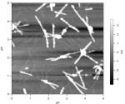(Press-News.org) Scientists have modeled a system that may be used to control mosquitoes and the diseases they transmit, without the use of pesticides. In the proposed system, mosquitoes are engineered to carry two genes. The first gene causes males to transmit a toxin to females through their semen. The second gene, when expressed in females, makes them immune to this toxin. This research, published in the February 2011 issue of Genetics (http://www.genetics.org), describes a system that can be created using currently available molecular tools and could confine the spread of mosquitoes to isolated populations. It also allows the genes to be recalled if necessary.
"I hope that the results of this theoretical study will inspire molecular biologists to explore new ways of driving transgenes into populations," said John M. Marshall, Ph.D., a researcher involved in the work from the Department of Infectious Disease Epidemiology, School of Public Health at the Imperial College of London in the United Kingdom. "Ultimately, I hope that the application of these ideas will help move transgenic mosquito technology forward, and thereby contribute to the many efforts to reduce the prevalence of malaria and dengue fever in disease-endemic countries."
The gene transfer system was modeled using mathematical equations that describe how genetic alterations in the mosquitos' DNA are inherited from one generation to the next, and predict how these alterations will either spread or be eliminated from the population. The system has two basic components—a toxin expressed in the semen of transgenic males that either kills female recipients or renders them infertile, and an antidote expressed in females that protects them from the effects of the toxin. An all-male release should result in population suppression because wild females that mate with transgenic males produce no offspring. A release that includes transgenic females propagates the desired gene because females carrying the toxin gene are favored at high population frequencies.
The scientists used simple population genetics models to explore the utility of this gene-transfer system, and found that it can work under a wide range of conditions. It requires a high frequency of gene transfer, which is desirable because it means that genetically altered insects released accidentally are unlikely to persist in the wild. Furthermore, it means that those released intentionally can be spatially confined and that the altered genes can be removed from a population through sustained release of wild-type insects. The scientists found few technical barriers to implementing this system, increasing prospects for engineering and testing in the coming years.
"Mosquito bites can mean more than an itchy annoyance," said Mark Johnston, Editor-in-Chief of the journal GENETICS. "For far too many people, they can lead to life-threatening diseases. But mosquitoes play a role in the greater ecosystem, and completely eradicating them may have unintended consequences that could be worse than the diseases they carry. This study is exciting because it suggests a way to control mosquito populations without pesticides, and in a way that gives us control of the process."
###
DETAILS: John M. Marshall, Geoffrey W. Pittman, Anna B. Buchman, and Bruce A. Hay, Semele: A Killer-Male, Rescue-Female System for Suppression and Replacement of Insect Disease Vector Populations,
Genetics 2011 187: 535�. http://www.genetics.org/cgi/content/abstract/187/2/535.
Since 1916, GENETICS (http://www.genetics.org) has covered high quality, original research on a range of topics bearing on inheritance, including population and evolutionary genetics, complex traits, developmental and behavioral genetics, cellular genetics, gene expression, genome integrity and transmission, and genome and systems biology. GENETICS, the peer-reviewed, peer-edited journal of the Genetics Society of America is one of the world's most cited journals in genetics and heredity.
New model reveals pesticide-free method that takes a bite out of mosquito-borne disease
Research published in Genetics proposes a system for spreading disease-resisting genes in mosquito populations
2011-02-14
ELSE PRESS RELEASES FROM THIS DATE:
UCSB chemists make discovery that may lead to drug treatment possibilities for Alzheimer's
2011-02-14
(Santa Barbara, Calif.) –– UC Santa Barbara scientists have made a discovery that has the potential for use in the early diagnosis and eventual treatment of plaque-related diseases such as Alzheimer's disease and Type 2 diabetes. Their work is published in a recent issue of Nature Chemistry.
The amyloid diseases are characterized by plaque that aggregates into toxic agents that interact with cellular machinery, explained Michael T. Bowers, lead author and professor in the Department of Chemistry and Biochemistry. Other amyloid diseases include Parkinson's disease, Huntington's ...
Pulmonary fibrosis inhibited by pentraxin-2/SAP in research study
2011-02-14
MALVERN, PA – February 10, 2011 – Promedior, Inc., a clinical stage biotechnology company developing novel therapies to treat fibrotic and inflammatory diseases, announced today the publication of collaborative research in the International Journal of Biochemistry and Cell Biology entitled, "TGF-beta driven lung fibrosis is macrophage dependent and blocked by Serum amyloid P." The research showed that human Pentraxin-2 (PTX-2), also called human Serum amyloid P (SAP), potently inhibits all undesirable pro-fibrotic pathologies driven by TGFβ1 and represents a novel ...
Chinks in the brain circuitry make some more vulnerable to anxiety
2011-02-14
Why do some people fret over the most trivial matters while others remain calm in the face of calamity? Researchers at the University of California, Berkeley, have identified two different chinks in our brain circuitry that explain why some of us are more prone to anxiety.
Their findings, published today (Thursday, Feb. 10) in the journal Neuron may pave the way for more targeted treatment of chronic fear and anxiety disorders. Such conditions affect at least 25 million Americans and include panic attacks, social phobias, obsessive-compulsive behavior and post-traumatic ...
Tumor microvesicles reveal detailed genetic information
2011-02-14
The Massachusetts General Hospital (MGH) research team that first discovered tumor-associated RNA in tiny membrane-enclosed sacs released into the bloodstream by cancer cells has now found that these microvesicles also contain segments of tumor DNA, including retrotransposons – also called "jumping genes" – that copy and insert themselves into other areas of the genome. The investigators' report, which has been published in Nature Communications, is the first to show that microvesicles are involved in transferring retrotransposons between cells.
"Retrotransposons' ...
UTHealth, Athersys preclinical research on stem cell therapy for stroke presented at AHA conference
2011-02-14
HOUSTON and LOS ANGELES – February 10th, 2011 – Medical researchers from The University of Texas Health Science Center at Houston (UTHealth) presented new research results at the American Heart Association International Stroke Conference that demonstrated how MultiStem®, a novel stem cell therapy being developed by Athersys, Inc. provided multiple benefits when administered in preclinical models of ischemic stroke. The study, conducted by leading researchers from the Department of Neurology at the UTHealth Medical School working in collaboration with scientists at Athersys, ...
Restructuring natural resource majors
2011-02-14
Madison, WI FEBRUARY 3, 2011 – A troublesome trend is occurring at colleges and universities around the country: fewer students are graduating with degrees in natural resource related degree programs. As a result, the number of qualified professionals to manage fish and wildlife programs is dwindling. What is even more troubling is that nationally, the percentage of students enrolling in the major has increased. For reasons unknown, students have been leaving the natural resource degree path after enrollment to pursue other degrees. Finding cause for the steady decline ...
Study related to diet soda and stroke risk is seriously flawed
2011-02-14
Contact: Stan Samples
ssamples@kellencompany.com
404-252-3663
Calorie Control Council
Study related to diet soda and stroke risk is seriously flawed
Study is drawing a growing body of criticism and skepticism from experts in the field of nutrition and science
The Calorie Control Council stated today that research findings presented during a poster session at the International Stroke Conference claiming an association between diet soft drink consumption and increased risk of stroke and heart attack are critically flawed.
"The findings are so speculative and preliminary ...
Sandia security experts help Kazakhstan safely transport, store Soviet-era bomb materials
2011-02-14
ALBUQUERQUE, N.M. — A Sandia National Laboratories team helped reach a major milestone in the nation's nuclear nonproliferation efforts by working with the Central Asian country of Kazakhstan to move nuclear materials — enough to build an estimated 775 nuclear weapons — to safety.
Sandia provided security and logistics expertise to complete the transfer across Kazakhstan of spent fuel containing 11 tons (10 metric tons) of highly enriched uranium and 3.3 tons (3 metric tons) of weapons-grade plutonium that had been stored in a BN-350 fast-breeder reactor in the busy Caspian ...
Wayne State study: Enhance romance by going out with other couples
2011-02-14
DETROIT— Romantic relationships often start out as enjoyable or even exciting, but sometimes may become routine and boring. A Wayne State University study reveals that dating couples that integrate other couples into their social lives are more likely to have happy and satisfying romantic relationships.
Richard B. Slatcher, Ph.D., assistant professor of psychology in WSU's College of Liberal Arts and Sciences and a resident of Birmingham, Mich., specializes in social and health psychology. His recent research suggests that spending quality time with other couples may ...
VCU Massey first to combine targeted agents to kill multiple myeloma cells
2011-02-14
Richmond, Va. (Feb. 10, 2011) – Scientists at Virginia Commonwealth University Massey Cancer Center have developed a novel treatment strategy for multiple myeloma that pairs two targeted agents to kill cancer cells. The study's findings, published in today's edition of the journal "Blood," are the first to demonstrate the synergistic, anti-myeloma effects of this combination regimen both in vitro and in vivo.
Multiple myeloma is a cancer involving antibody-producing cells in the bone marrow, and, in most cases, is incurable. Targeted therapies work by interfering with ...
LAST 30 PRESS RELEASES:
First Editorial of 2026: Resisting AI slop
Joint ground- and space-based observations reveal Saturn-mass rogue planet
Inheritable genetic variant offers protection against blood cancer risk and progression
Pigs settled Pacific islands alongside early human voyagers
A Coral reef’s daily pulse reshapes microbes in surrounding waters
EAST Tokamak experiments exceed plasma density limit, offering new approach to fusion ignition
Groundbreaking discovery reveals Africa’s oldest cremation pyre and complex ritual practices
First breathing ‘lung-on-chip’ developed using genetically identical cells
How people moved pigs across the Pacific
Interaction of climate change and human activity and its impact on plant diversity in Qinghai-Tibet plateau
From addressing uncertainty to national strategy: an interpretation of Professor Lim Siong Guan’s views
Clinical trials on AI language model use in digestive healthcare
Scientists improve robotic visual–inertial trajectory localization accuracy using cross-modal interaction and selection techniques
Correlation between cancer cachexia and immune-related adverse events in HCC
Human adipose tissue: a new source for functional organoids
Metro lines double as freight highways during off-peak hours, Beijing study shows
Biomedical functions and applications of nanomaterials in tumor diagnosis and treatment: perspectives from ophthalmic oncology
3D imaging unveils how passivation improves perovskite solar cell performance
Enriching framework Al sites in 8-membered rings of Cu-SSZ-39 zeolite to enhance low-temperature ammonia selective catalytic reduction performance
AI-powered RNA drug development: a new frontier in therapeutics
Decoupling the HOR enhancement on PtRu: Dynamically matching interfacial water to reaction coordinates
Sulfur isn’t poisonous when it synergistically acts with phosphine in olefins hydroformylation
URI researchers uncover molecular mechanisms behind speciation in corals
Chitin based carbon aerogel offers a cleaner way to store thermal energy
Tracing hidden sources of nitrate pollution in rapidly changing rural urban landscapes
Viruses on plastic pollution may quietly accelerate the spread of antibiotic resistance
Three UH Rainbow Babies & Children’s faculty elected to prestigious American Pediatric Society
Tunnel resilience models unveiled to aid post-earthquake recovery
Satellite communication systems: the future of 5G/6G connectivity
Space computing power networks: a new frontier for satellite technologies
[Press-News.org] New model reveals pesticide-free method that takes a bite out of mosquito-borne diseaseResearch published in Genetics proposes a system for spreading disease-resisting genes in mosquito populations

